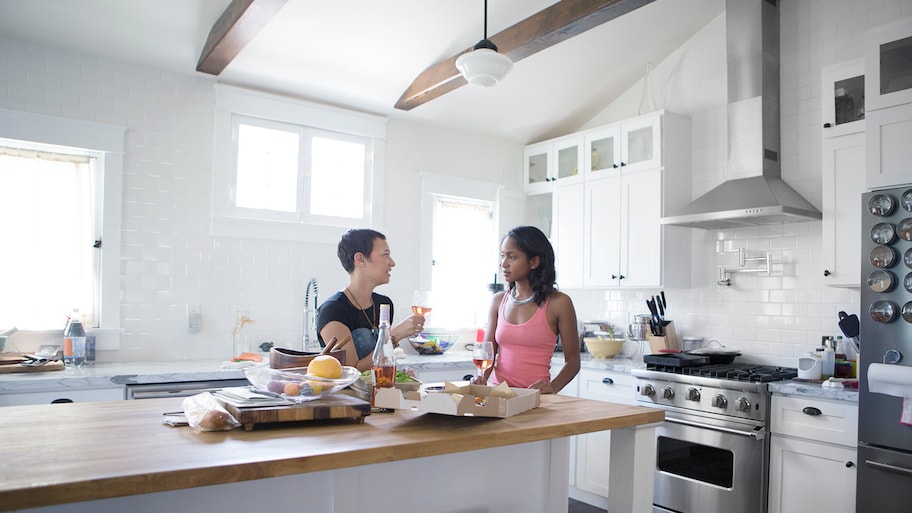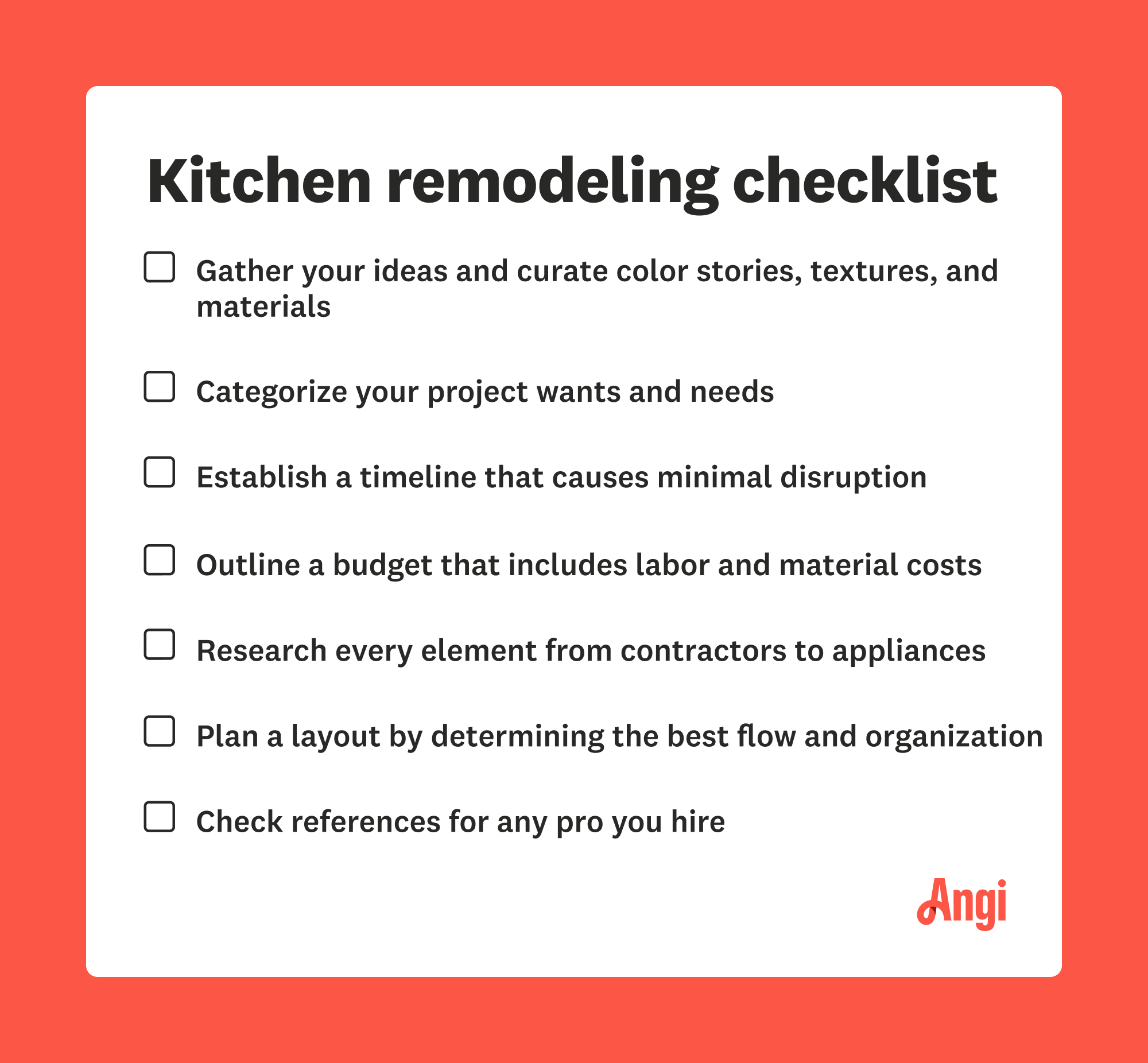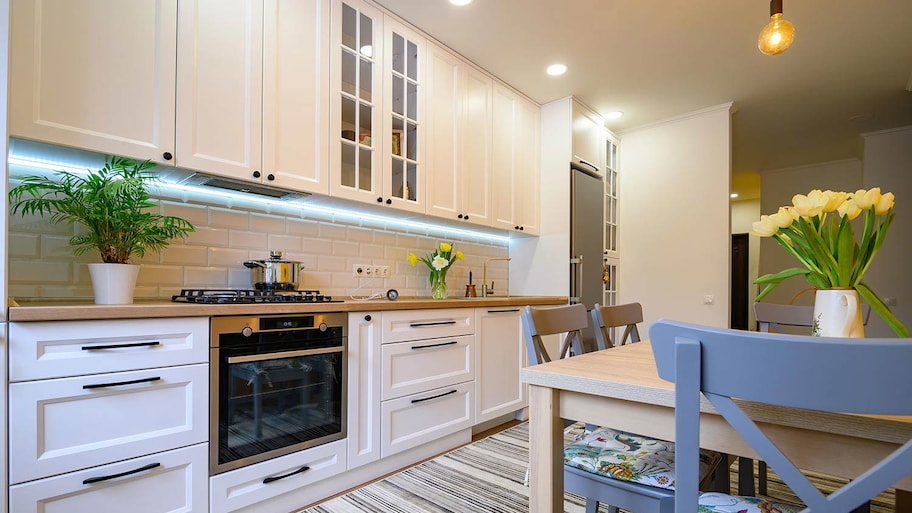Kitchen Remodel Checklist to Help You Plan Your Project
Prepare for your kitchen remodel with this handy checklist


If you ask homeowners, most would likely say a kitchen remodel is on their home project wish list. That’s where our helpful kitchen remodel checklist comes in. After all, kitchens are a heavily used, important part of the home and when the space isn’t functional or has a backsplash that makes you cringe every time, an update feels necessary.
A kitchen remodel can be an exciting project for homeowners looking to spruce up their space, but planning a kitchen renovation can feel daunting. Use this checklist to help you plan your renovation, from finding inspiration to budgeting for the upgrades, and make the remodel process stress free.
What Does a Kitchen Remodel Typically Include?
Deciding what to include in your kitchen remodel checklist can help you spend your money wisely. Perhaps you have enough of a budget to include everything you want. However, if your budget has limitations, you can use this list to determine which items give you the biggest bang for your buck.
Cabinet Costs: $2,000–$28,000
Countertop Costs: $2,000–$10,000
Appliance Costs: $100–$5,000
Flooring Costs: $1,000–$4,000
Lighting Costs: $500–$2,000
Electrical Line Costs: $500–$2,000
Plumbing Costs: $200–$2,000
Backsplash Costs: $600–$1,300
Gas Line Costs: $250–$750
Paint Costs: $100–$500
Although most individual segments of the remodeling work will fit in these ranges, you may have a project outside the range. Kitchen cabinets, for example, are the most expensive item in most kitchen remodels. However, you do have the option of painting or refacing kitchen cabinets instead of replacing them to save quite a bit of money.
Determine Your Priorities
Now it’s time to determine how your dream kitchen will become a reality. That means deciding what on your wishlist takes priority over the other items.
To determine the priorities on your kitchen remodel checklist, consider splitting the items into groups that indicate their importance to you. Don’t just rank items on what needs replacing now and what can wait. Put some thought into what you want to accomplish with the remodeling work.
Items that can make it more enjoyable to spend time in this space or that can improve your ability to cook can be priorities just as much as replacing an old refrigerator that is on its last legs.
Non-negotiable: If you do kitchen remodeling primarily to fix or upgrade certain items, these would fit in the non-negotiable area. If your cabinets are falling apart or your kitchen sink simply isn’t large enough to match how you use it, these items must be part of the project.
Primary wants: If you want to modernize the kitchen or simply upgrade certain areas, you can prioritize these. Maybe a new countertop isn’t absolutely necessary, but you really, really want one to upgrade the look and feel of the space. It might be a primary reason you are making a kitchen remodel checklist, so it should be in this group.
Nice to have: Your kitchen remodel checklist should include items that can wait until the next remodeling project. However, if you find a good price on them or if your budget ends up being large enough to accommodate them, they’re already on the list. You can go ahead and do them now.
Future-proofing: Finally, you should include some items that you may want several years down the road. Say you are just starting a family. Maybe you want a kitchen island that offers multiple seats for the kids, even though you don’t really need them now. Certainly, this item can wait, but if you have enough budget available, it may be easier to go ahead and do it now while you already have a contractor on site.
Create a Budget

Kitchen renovations are expensive, and creating a budget is a key part of the process. The average kitchen remodel costs $26,300, but costs range from $14,600 and $40,600, depending on the scope and size of the project.
Prioritize replacing broken or hazardous features
Create a budget based on your cost estimate research for labor and materials
Add 5%-10% additional wiggle room for unexpected expenses
Price out what cosmetic upgrades fit into your budget
Get price estimates from multiple kitchen design pros in your area
Research With Your Budget in Mind
This is where the fun begins! Browse your favorite magazines and social media feeds for appliances, cabinets, backsplash ideas, and other inspiration for how you want your kitchen remodel to look. Function comes first for kitchens, so be sure to research if your dream kitchen will work with your lifestyle. It’s also important to get cost estimates on the features you love to see what is feasible in your budget.
Save photos of kitchens and features you love
Create a wish list for your new kitchen
Decide on a color palette
Get cost estimates for features and appliances
Consult a kitchen design pro to design a functional space
Determine which type of kitchen layout will work best
Consider the amount of storage space required
Decide On a Project Timeline
Many people overlook that the timing of a kitchen remodel project can be an important factor in the project’s success (and your sanity).
It’s a good idea to understand how long a kitchen remodel will take so you can choose a time of the year that works best for your household’s lifestyle. Plus, some contractors charge more for remodels during the summer months since the demand is higher.
Choose the time of the year that works best for your schedule and budget
Find alternative ways to cook while the renovation is underway
Consult with potential contractors about the project timeline
Determine the order of tasks to complete during the remodeling process
Determine the New Layout
You may need to adjust the kitchen layout to accommodate new items, like a kitchen island or larger cabinets. It’s important to have the design done before tearing items out, so you can be certain everything will fit and look good.
If you don’t feel comfortable drawing up design plans and taking the detailed measurements required, help is available from a professional kitchen designer. Some contractors will do this design work for you, too.
How much does a kitchen designer cost? Most designers charge between roughly $5,000 and $30,000, depending on the total amount of work. A local kitchen design professional can give you an estimate.
While you probably will have to work with the square footage you already have (unless you’re adding on), there are ways to use the space smarter to make it feel larger. As you plan the layout, make sure to include the following features:
Appliances
Sink
Cabinets
Countertops
Eating space, if applicable
Lighting
Floors
Hardware
Decor, if applicable
Of course, if you focus more on updates and are not changing the size of anything in the space, a new layout won’t be necessary.
Pull Permits
Depending on where you live, you may need permits from local governmental agencies before starting the kitchen remodeling work. The national cost average for obtaining permits starts around $450, but this cost can vary greatly depending on your local requirements.
As you are figuring out who to hire for a kitchen remodel, ask the candidates about how they handle obtaining permits. Many contractors will handle the entire permitting process for you. This is a nice feature, as contractors are almost certainly going to be more familiar with obtaining permits than you, saving time and avoiding setbacks.
Some local entities want precise design plans, while others require separate permits to handle electrical and plumbing work. All of these differences can be confusing for novices.
Hire a Kitchen Remodel Contractor

It’s time to find a professional to help you bring your vision to life. While there are some projects you can try to do yourself, like building a kitchen island, a kitchen contractor can take on the more complicated tasks, such as wiring or plumbing. They can also help you plan your remodel and execute your kitchen remodel efficiently and effectively. Here are some tips for how to hire a kitchen remodeling contractor.
See what contractors are available to complete your project during your preferred time frame.
Get at least three quotes from kitchen remodel professionals in your area before you hire anyone.
Ask contractors for customer references.
Share your ideas and budget with your contractor.
Purchase Cabinets, Appliances, and Any Other Items That Will Need to be Installed
At this point, you have your budget, layout, and contractor ready to go. You now can find the appliances and features that will transform your kitchen.
It’s best to select and purchase your new kitchen appliances after hiring your contractor and deciding on your goals for the remodel. This way, you can be sure your appliances will be a good fit—literally—for your kitchen design.
Think about the following when choosing your new features:
Pick and order kitchen cabinets first (if applicable) because they have the longest lead time.
Work with your contractor to see what other features have long lead times, such as flooring, and pick those items next.
Use your color palette to help you find countertops, paint colors, or a backsplash to keep the space cohesive.
Match your sink to the rest of the appliances or other features of the design (e.g. stainless steel appliances and a stainless steel sink).
Finally, you should decide whether you want to purchase certain items yourself or whether you’ll allow the contractor to source them. For example, the contractor may be willing to purchase, deliver, and install your new appliances, but you’ll pay a markup versus doing the shopping yourself.
On a smaller scale, you may want the contractor to pick up the tile for your backsplash for you or to provide the grout and paint. Each item will be a little more expensive if the contractor provides them than if you shop for them yourself. However, it’s also possible that your contractor will not use the bargain-priced grout that you select because of concerns over quality. Check with your contractor on how to handle things like this.
Prepare to Live Without a Real Kitchen for a While
You may become so enthralled with the idea of setting up your kitchen remodel checklist that you forget about the downside to this type of work—you will be without a functioning kitchen for several weeks. Takeout food from restaurants is fine for a while, but you will want options for making your own food, too.
One of the best options for surviving a kitchen remodel is to set up a temporary kitchen elsewhere in the home. If you have counter space in a basement or in a laundry room, you may be able to do some cooking there. Maybe a spare refrigerator fits in the garage. Fire up the patio grill, as you can use it for many different kinds of food. Make some plans for simple meals you can put together with limited tools and appliances.
Understand that just because the contractor gives you a seven week timeline, your remodel could end up taking longer. Always put together a temporary kitchen plan that you can continue to use if the contractor misses the deadline.
Consider DIYing Parts of the Project
After you receive a quote from your kitchen contractor, you may find that your budget isn’t quite large enough to allow you to do everything you want. At this point, you potentially can save some money by doing a bit of the work yourself.
Some items require the skill of a professional, such as rewiring to add kitchen outlets or moving a gas line for your new stove. Other items, such as tearing up an old floor, upgrading cabinets with DIY techniques, or hauling away old appliances, may be right up your alley. When you reduce the amount of work the contractor must do, you can save money.
Before you DIY part of the kitchen remodel—while expecting the contractor to handle the rest of the work—check with the contractor. Some will not want you to do any DIY work in the space, while others are willing to work with you. If you have any plans to DIY part of the job, make this clear to the contractor in the process of obtaining bids.
Emily Benda Gaylord contributed to this piece.
